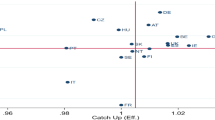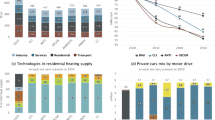Abstract
Even though environmental innovations are generally considered a key element towards a green growth strategy, especially for the case of energy efficiency innovations, the impact on climate goals has been subject to a long-running debate. On the one hand, energy efficiency innovations provide a huge cost-effective CO2 reduction potential. On the other hand, increasing energy efficiency implies cost reductions which in turn may lead to increased consumption due to the so-called rebound effect. Our study investigates the long-term environmental impact of energy efficiency innovations on the EU-27 residential electricity demand (excluding heating systems) using a detailed bottom-up modelling approach. Assuming a rebound effect of 10 %, we show that the diffusion of energy efficiency technologies with current policy levels provides savings of around 140 TWh and additional 270 TWh may be saved through additional policy measures accelerating the diffusion and development of new technologies until 2030. By contrast, assuming a (rather pessimistic) rebound effect of 40 %, the savings are reduced to around 95 and 180 TWh until 2030, respectively. We conclude that there is a clear case for ambitious policies to support energy efficiency innovations for the residential sector, which ideally should be complemented by measures to limit the rebound effect.








Similar content being viewed by others
Notes
FORECAST (FORecasting Energy Consumption Analysis and Simulation Tool) is a modelling platform that captures the final energy demand of the industry, residential, tertiary, transport and agriculture sector (http://www.forecast-model.eu).
In addition, FORECAST-Residential also captures the useful and final energy demand for heating purposes, which are not part of this study (Elsland et al. 2014).
References
Allcott H, Greenstone M (2012) Is there an energy efficiency gap? J Econ Perspect 26(1):3–28
Antal M, van den Bergh JCJM (2014) Re-spending rebound: a macro-level assessment for OECD countries and emerging economies. Energy Polic 68:585–590
Attali S, Bush E, Michel A (2011) Factors influencing the penetration of energy efficient appliances into national markets in Europe. In: Proceedings of the EEDAL conference
Barker T, Dagoumas A, Rubin J (2009) The macroeconomic rebound effect and the world economy. Energ Effic 2:411–427
Bass F (1969) A new product growth model for consumer durables. Manag Sci 15:215–217
Bull J (2012) Loads of green washing—can behavioural economics increase willingness-to-pay for efficient washing machines in the UK? Energy Polic 50:242–252
Consumer Focus (2012) Under the influence? Consumer attitudes to buying appliances and energy labels. Available at http://www.consumerfocus.org.uk/files/2012/12/Under-the-influence.pdf
Costantini V, Crespi F, Palma A (2014) Policy inducement effects in energy efficiency technologies. An empirical analysis on the residential sector. Seeds Working Paper Series 19/2014
Edler J (2013) Review of policy measures to stimulate private demand for innovations: concepts and effects. NESTA Compendium
Elsland R, Schlomann B, Eichhammer W (2013) Is enough electricity being saved? Impact of energy efficiency policies addressing electrical houshold appliances in Germany until 2030. (Hyères, Ed.) Summer Study on Energy Efficiency (ECEEE)
Elsland R, Bradke H, Wietschel M (2014) A European impact assessment of the Eco-Design requirements for heating systems—what kind of savings can we expect? Energy Procedia 62:236–245
European Commission (2013) EU energy, transport and GHG emissions—trends to 2050. http://ec.europa.eu/energy/sites/ener/files/documents/trends_to_2050_update_2013.pdf
Fraunhofer ISI, TU Wien, PWC (2014). Study evaluating the current energy efficiency policy framework in the EU and providing orientation on policy options for realising the cost-effective energy efficiency/saving potential until 2020 and beyond. http://ec.europa.eu/energy/efficiency/studies/doc/2014_report_2020-2030_eu_policy_framework.pdf
Foxon TJ, Köhler J, Oughton C (2008) Innovation for a low carbon economy. Edward Elger Publishing Limited
Gillingham K, Kotchen M, Rapson D, Wagner G (2013) The rebound effect is overplayed. Nature 493:475–476
Greening L, Greene D, Difiglio C (2000) Energy efficiency and consumption—the rebound effect—a survey. Energy Polic 28:389–401
IEA. (2012). Progress implementing the IEA 25 energy policy recommendations. International energy agency insight series
IEA (2014) Energy efficiency market report. International energy agency IEA
Jaffe AB, Stavins RN (1994) The energy paradox and the diffusion of conservation technology. Resour Energy Econ 16:91–122
Kaenzig J, Wuestenhagen R (2009) The effect of life cycle cost information on consumer investment decisions regarding eco-innovation. Ind Ecol 14:121–136
PSI & BIOIS (2011) Impacts of innovation on the regulatory costs of energy-using product policy. Policy Studies Institute & BIO Intelligence Service
Revelt D, Train K (1997) Mixed logit with repeated choices: household’s choice of appliance efficiency level. Rev Econ Stat 80:1–11
Schiellerup P, Atanasiu B (2011) Innovations for a low-carbon economy—an overview and assessment of the eu policy landscape. A report for WWF Sweden—final report. Institute for European Environmental Policy (IEEP), Brussels, Belgium. pp 56+Appendices
Schleich J, Mills B, Dütschke E (2014) A brighter future? Quantifying the rebound effect in energy efficient lighting. Energy Policy 72:35–42
Sorrell S, Dimitropoulos J (2008) The rebound effect: microeconomic definitions, limitations and extensions. Ecol Econ 65:636–649
Sorrell S, Dimitropoulos J, Sommerville M (2009) Empirical estimates of the direct rebound effect: a review. Energy Polic 37:1356–1371
Wilson C, Grubler A, Gallagher KS, Nemet G (2012) Marginalization of end-use technologies in energy innovation for climate protection. Nat Clim Change 2:780–788
Author information
Authors and Affiliations
Corresponding author
Appendix: labelling and ecodesign implementing measures in the diffusion scenario
Appendix: labelling and ecodesign implementing measures in the diffusion scenario
See Table 1
About this article
Cite this article
Braungardt, S., Elsland, R. & Eichhammer, W. The environmental impact of eco-innovations: the case of EU residential electricity use. Environ Econ Policy Stud 18, 213–228 (2016). https://doi.org/10.1007/s10018-015-0129-y
Received:
Accepted:
Published:
Issue Date:
DOI: https://doi.org/10.1007/s10018-015-0129-y




